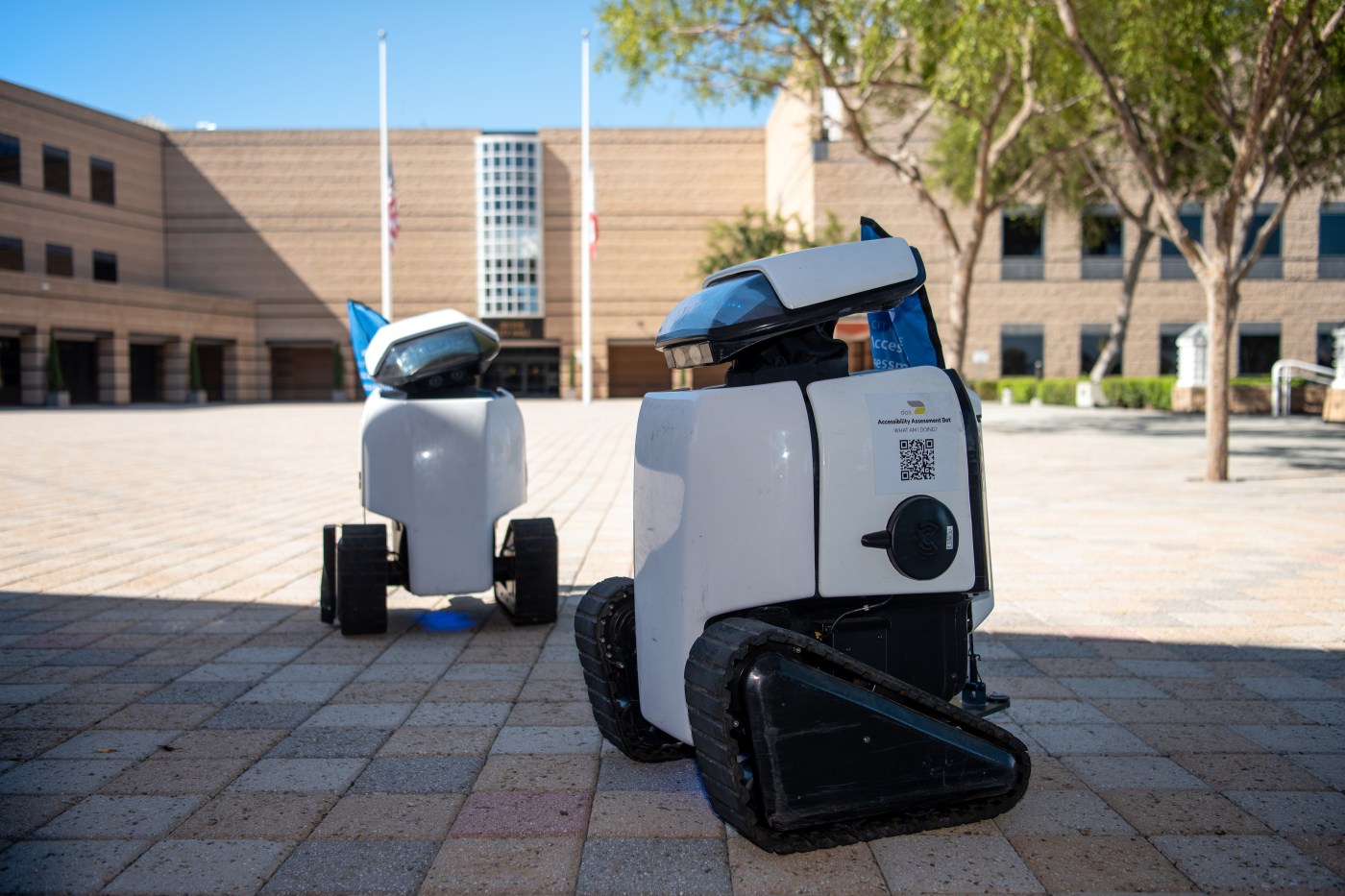If Pixar’s Wall-E and Eve had a kid, it might look a lot like Smokey and Turbo — two white, tread-wheeled service robots with big blue eyes that can light up into smiles or even heart shapes.
Aim a camera at them, and they cock their heads as if they’re posing.
The pair — along with up to four more — are part of Irvine’s latest effort to keep its massive network of curb ramps, sidewalks and trails compliant with the Americans with Disabilities Act.
Since late August, the city has been deploying the sensor-equipped robots, developed by Oregon-based Daxbot, to scan for cracks, slopes and other barriers. Their measurements will feed into Irvine’s ADA self-evaluation program, a review officials say will help shape future upgrades.
The city maintains more than 9,000 curb ramps, nearly 1,000 miles of sidewalks, plus dozens of parks and public buildings. Keeping all of that accessible isn’t a small task, said city spokesperson Linda Fontes. The robots offer a way to cover ground more quickly and consistently than sending out staff with clipboards.
“The data collection process can be done up to five times faster than traditional methods. The ground data being collected can be analyzed in the office for further assessment without the need for multiple site visits,” she said.
The city has hired Bureau Veritas, which is working with Daxbot, to run the project. Three robots are currently deployed in Irvine, with the fleet expected to expand to six. They’re starting in the southern part of the city and will eventually work their way north over the next several months.
The robots are out on city streets weekdays during the day. Their locations are tracked in real time, and a field technician is nearby to step in if any technical issues come up, said Andy Craig, who manages the project for Daxbot.
Each robot is about the size of a small cooler and weighs 150 pounds — most of it a battery that runs up to 12 hours a day. Craig said the machines are built to move cautiously through neighborhoods.
“When they’re assessing a strip of sidewalk, they have AI systems that basically are looking out for people in wheelchairs, pedestrians, and if they see someone, they’ll stop and immediately alert a human operator,” Craig said. “And so the human operator will take over control and just make sure they yield and get out of the way.”
The robots can follow pre-mapped paths, but also have a “seek and find” function to locate walkways on their own if needed. In Irvine, Craig said, the routes are mostly predetermined.
The robots are scanning for a variety of details that affect accessibility. That includes level changes that could be tripping hazards, slopes, pathway widths, low clearances, and obstructions. For curb ramps, they measure slope, length, width, landing space and whether detectable warning surfaces are in place.
Craig said the bots gather data faster and far more precisely than humans can. It would take a human crew “at least double” the time it would take a robot to do the work, he said.
“And you’re going to get way less data. So if a human was to do it, they have their level, they have their tools, and then they have to go do a lunge, put the stuff on the ground,” he said. “The other benefit here is we’re taking measurements every centimeter. But if a human crew is doing it, they can only take really one measurement per slab.”
Vu Tran, a civil engineer with the city who is overseeing the project, added that humans typically measure at 10-foot intervals, which can miss problem spots. Getting more detail would “expand the schedule significantly,” he said.
The program isn’t cheap; about $600,000 for the sidewalks, ramps and trails, but Fontes said it’s still less expensive than a traditional inspection. Another $320,000 is set aside for in-person checks of public buildings and parks.
For residents concerned about privacy, Fontes said the robots aren’t collecting faces or license plates.
“The robots will be collecting ground photos of the hardscape being assessed,” she said, “not collecting or recording facial images or license plates.”
Mayor Larry Agran called the project both practical and a little playful.
“We’re always looking for better ways to do things,” he said. “This is a pilot program that lets us use modern technology, have a little fun along the way and make sure Irvine stays in compliance with the ADA while staying ahead of the curve.”
The city expects the bots to wrap up their work in about six months, Fontes said. After that, staff will evaluate the findings and present them to the City Council. Repairs or upgrades will then be slotted into the city’s capital improvement projects.












